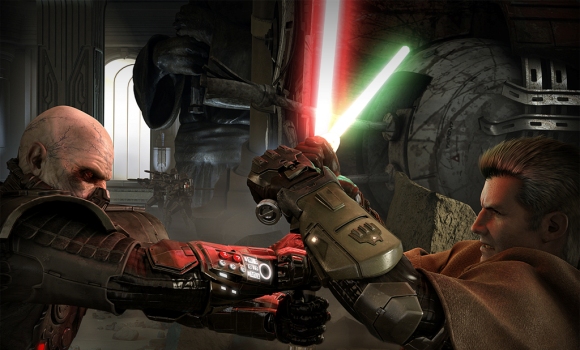
Roughly halfway through my viewing of the exquisitely crafted E3 trailer for Star Wars: The Old Republic, I felt that something was wrong. Was it the coloration of the troopers' armor as they loosed salvo after salvo of withering laser fire? No. Were the veins of agony etched across the features of the Sith warriors too distracting? That couldn’t be it….
Then it hit me, as powerful as any love tap with a lightstaber to the face: This trailer contained absolutely no gameplay footage whatsoever. My considerably palpable level of excitement was caused by a Michael Bay-style explosion-fest masquerading as a video-game trailer.
The industry’s use of sleek cinematic trailers is pervasive at best and excessive at worst. Big-name studios such as BioWare and Blizzard pour their resources into increasingly grandiose preview videos — the recently released DC Universe Online trailer is a stark example. In practical terms, they are intended as a sales pitch, garnering fervor among consumers for an impending title. In reality, they mislead consumers on the actual content of the title.

I accept that high-strung action scenes set the bar for excitement in a cinematic trailer. At the same time, I fail to see the correlation between what is depicted on the screen — such as intricate acrobatics — and what the game can actually replicate. As the most vivid representation of a game’s various elements, trailers require accuracy.
Common sense dictates an implicit distinction between what we see in a trailer and what is feasible in a game. Unfortunately, gamers unfamiliar with an upcoming title’s progress are usually immune to this logic, dispensing such deceived comments as “Wow! I hope the game will look like this.” The main culprit? A lack of gameplay footage to supplant their cinematic counterparts.
Luckily, certain development studios — usually of a diminutive caliber — are on pace to invigorate the dearth of meaningful game trailers. City Interactive's recently released Sniper: Ghost Warrior for the PC enticed gamers with clips featuring its lush jungle setting, interspersed with satisfyingly visceral headshots. IO Interactive's punchy in-game vignettes of Kane and Lynch 2 propelled the game's grittiness into the forefront without the aid of cheap special effects.

Color me old fashioned, but I remember a time when a game’s properties spoke for itself via demo discs and videos depicting actual game footage. My fervent wish is for a return to the halcyon days of game advertisement, dialing back visually bloated, hyperbolic content in favor of something more easily digestible. Cinematics certainly have their place within this industry — as an intro to a game's startup sequence, they're second to none — but utilized as a first impression, publishers can use far more effective strategies.


